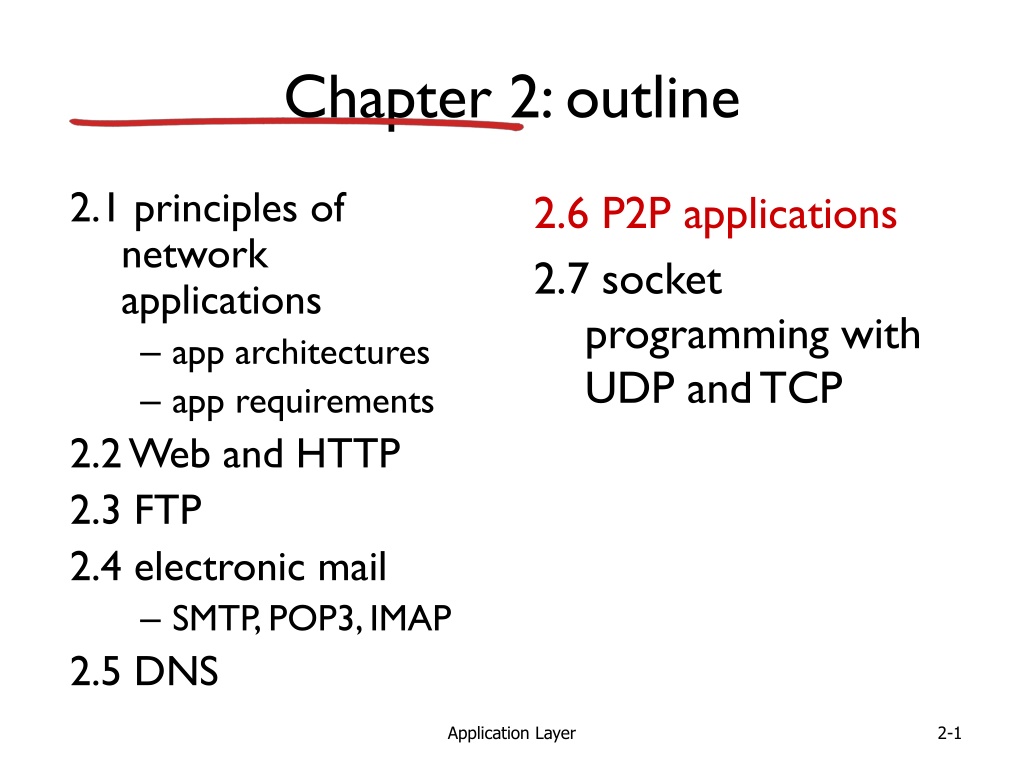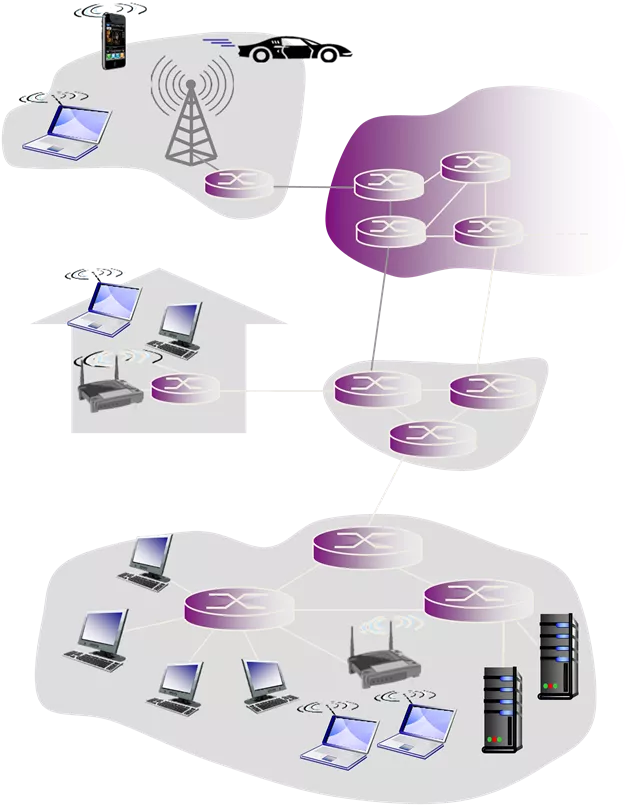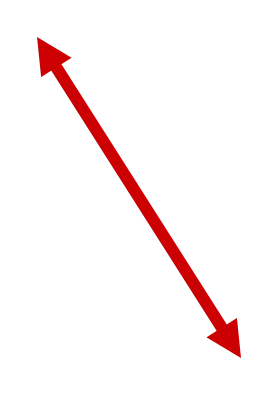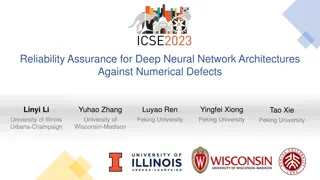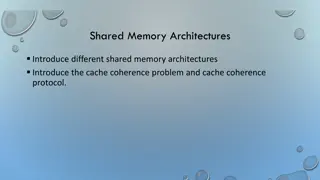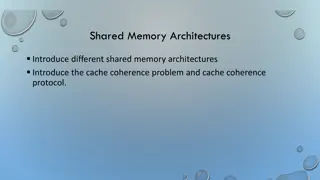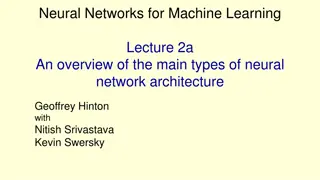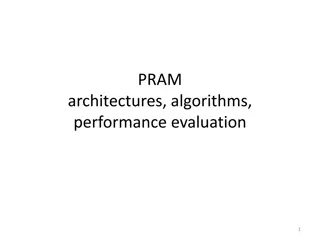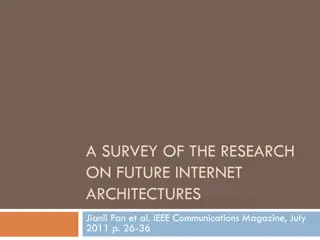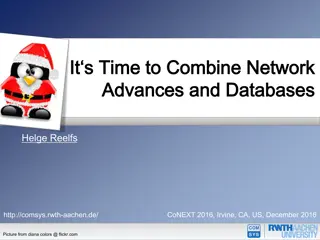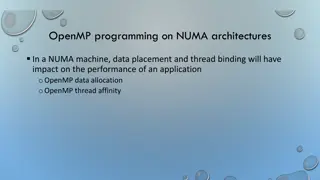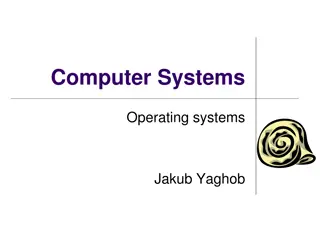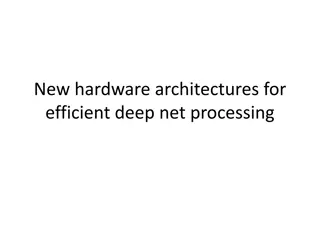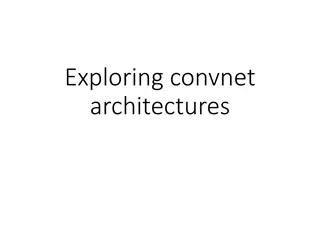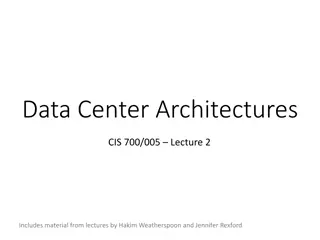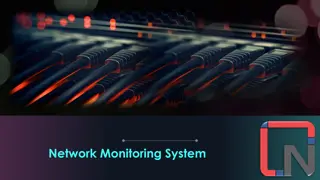Principles of Network Applications and Architectures
The principles of network applications, architectures, and requirements, including web, FTP, electronic mail, DNS, P2P applications, and socket programming with UDP and TCP. Delve into pure P2P architecture, file distribution comparisons between client-server and P2P, and the dynamics of distributing files to multiple clients. Understand the time complexities and performance considerations of various distribution approaches.
Download Presentation

Please find below an Image/Link to download the presentation.
The content on the website is provided AS IS for your information and personal use only. It may not be sold, licensed, or shared on other websites without obtaining consent from the author.If you encounter any issues during the download, it is possible that the publisher has removed the file from their server.
You are allowed to download the files provided on this website for personal or commercial use, subject to the condition that they are used lawfully. All files are the property of their respective owners.
The content on the website is provided AS IS for your information and personal use only. It may not be sold, licensed, or shared on other websites without obtaining consent from the author.
E N D
Presentation Transcript
Chapter 2: outline 2.1 principles of network applications app architectures app requirements 2.2 Web and HTTP 2.3 FTP 2.4 electronic mail SMTP, POP3, IMAP 2.5 DNS 2.6 P2P applications 2.7 socket programming with UDP and TCP Application Layer 2-1
Pure P2P architecture no always-on server arbitrary end systems directly communicate peers are intermittently connected and change IP addresses examples: file distribution (BitTorrent) Streaming (KanKan) VoIP (Skype) Application Layer 2-2
File distribution: client-server vs P2P Question: how much time to distribute file (size F) from one server to N peers? peer upload/download capacity is limited resource us: server upload capacity di: peer i download capacity u1 d1 file, size F u2 us d2 server di uN network (with abundant bandwidth) ui dN ui: peer i upload capacity Application Layer 2-3
File distribution time: client-server server transmission: must sequentially send (upload) N filecopies: time to send one copy: F/us time to send N copies: NF/us client: each client must download file copy dmin = min client download rate min client download time: F/dmin F us di network ui time to distribute F to N clients using client-server approachDc-s > max{NF/us,,F/dmin} increases linearly in N Application Layer 2-4
File distribution time: P2P server transmission: must upload at least onecopy time to send one copy: F/us client: each client must download file copy min client download time: F/dmin clients: as aggregate must download NF bits max upload rate (limting max download rate) is us + ui F us di network ui time to distribute F to N clients using P2P approach DP2P > max{F/us,,F/dmin,,NF/(us + ui)} increases linearly in N but so does this, as each peer brings service capacity Application Layer 2-5
Client-server vs. P2P: example client upload rate = u, F/u = 1 hour, us = 10u, dmin us 3.5 P2P Client-Server Minimum Distribution Time 3 2.5 2 1.5 1 0.5 0 0 5 10 15 20 25 30 35 N Application Layer 2-6
P2P file distribution: BitTorrent file divided into 256Kb chunks peers in torrent send/receive file chunks torrent: group of peers exchanging chunks of a file tracker: tracks peers participating in torrent Alice arrives obtains list of peers from tracker and begins exchanging file chunks with peers in torrent Application Layer 2-7
P2P file distribution: BitTorrent peer joining torrent: has no chunks, but will accumulate them over time from other peers registers with tracker to get list of peers, connects to subset of peers ( neighbors ) while downloading, peer uploads chunks to other peers peer may change peers with whom it exchanges chunks churn: peers may come and go once peer has entire file, it may (selfishly) leave or (altruistically) remain in torrent Application Layer 2-8
BitTorrent: requesting, sending file chunks sending chunks: tit-for-tat Alice sends chunks to those four peers currently sending her chunks at highest rate other peers are choked by Alice (do not receive chunks from her) re-evaluate top 4 every10 secs every 30 secs: randomly select another peer, starts sending chunks optimistically unchoke this peer newly chosen peer may join top 4 requesting chunks: at any given time, different peers have different subsets of file chunks periodically, Alice asks each peer for list of chunks that they have Alice requests missing chunks from peers, rarest first Application Layer 2-9
BitTorrent: tit-for-tat (1) Alice optimistically unchokes Bob (2) Alice becomes one of Bob s top-four providers; Bob reciprocates (3) Bob becomes one of Alice s top-four providers higher upload rate: find better trading partners, get file faster ! Application Layer 2-10
BitTorrent Animation How BitTorrent Works (explained with cardboard cutouts 11
Distributed Hash Table (DHT) DHT: a distributed P2P database database has (key, value) pairs; examples: key: ss number; value: human name key: movie title; value: IP address Distribute the (key, value) pairs over the (millions of peers) a peer queries DHT with key DHT returns values that match the key peers can also insert (key, value) pairs Application 2-12
Q: how to assign keys to peers? central issue: assigning (key, value) pairs to peers. basic idea: convert each key to an integer Assign integer to each peer put (key,value) pair in the peer that is closest to the key Application 2-13
DHT identifiers assign integer identifier to each peer in range [0,2n-1] for some n. each identifier represented by n bits. require each key to be an integer in same range to get integer key, hash original key e.g., key = hash( Led Zeppelin IV ) this is why its is referred to as a distributed hash table Application 2-14
Assign keys to peers rule: assign key to the peer that has the closest ID. convention in lecture: closest is the immediate successor of the key. e.g., n=4; peers: 1,3,4,5,8,10,12,14; key = 13, then successor peer = 14 key = 15, then successor peer = 1 Application 2-15
Circular DHT (1) 1 3 15 4 12 5 10 8 each peer only aware of immediate successor and predecessor. overlay network Application 2-16
Circular DHT (1) O(N) messages on avgerage to resolve query, when there are N peers 0001 Who s responsible for key 1110 ? I am 0011 1111 1110 0100 1110 1110 1100 0101 1110 1110 Define closest as closest successor 1110 1010 1000 Application 2-17
Circular DHT with shortcuts 1 Who s responsible for key 1110? 3 15 4 12 5 10 8 each peer keeps track of IP addresses of predecessor, successor, short cuts. reduced from 6 to 2 messages. possible to design shortcuts so O(log N) neighbors, O(log N) messages in query Application 2-18
Peer churn 1 handling peer churn: peers may come and go (churn) each peer knows address of its two successors each peer periodically pings its two successors to check aliveness if immediate successor leaves, choose next successor as new immediate successor 3 15 4 12 5 10 8 example: peer 5 abruptly leaves peer 4 detects peer 5 departure; makes 8 its immediate successor; asks 8 who its immediate successor is; makes 8 s immediate successor its second successor. what if peer 13 wants to join? Application 2-19
Chapter 2: outline 2.1 principles of network applications app architectures app requirements 2.2 Web and HTTP 2.3 FTP 2.4 electronic mail SMTP, POP3, IMAP 2.5 DNS 2.6 P2P applications 2.7 socket programming with UDP and TCP Application Layer 2-20
Socket programming goal: learn how to build client/server applications that communicate using sockets socket: door between application process and end-end- transport protocol application process application process socket controlled by app developer transport transport controlled by OS network network link link Internet physical physical Application Layer 2-21
Socket programming Two socket types for two transport services: UDP: unreliable datagram TCP: reliable, byte stream-oriented Application Example: 1. Client reads a line of characters (data) from its keyboard and sends the data to the server. 2. The server receives the data and converts characters to uppercase. 3. The server sends the modified data to the client. 4. The client receives the modified data and displays the line on its screen. Application Layer 2-22
Socket programming with UDP UDP: no connection between client & server no handshaking before sending data sender explicitly attaches IP destination address and port # to each packet rcvr extracts sender IP address and port# from received packet UDP: transmitted data may be lost or received out-of-order Application viewpoint: UDP provides unreliable transfer of groups of bytes ( datagrams ) between client and server Application Layer 2-23
Client/server socket interaction: UDP client server (running on serverIP) create socket: clientSocket = socket(AF_INET,SOCK_DGRAM) create socket, port= x: serverSocket = socket(AF_INET,SOCK_DGRAM) Create datagram with server IP and port=x; send datagram via clientSocket read datagram from serverSocket write reply to serverSocket specifying client address, port number read datagram from clientSocket close clientSocket Application 2-24
Example app: UDP client Python UDPClient include Python s socket library from socket import * serverName = hostname serverPort = 12000 clientSocket = socket(socket.AF_INET, socket.SOCK_DGRAM) message = raw_input( Input lowercase sentence: ) clientSocket.sendto(message,(serverName, serverPort)) modifiedMessage, serverAddress = clientSocket.recvfrom(2048) print modifiedMessage clientSocket.close() create UDP socket for server get user keyboard input Attach server name, port to message; send into socket read reply characters from socket into string print out received string and close socket Application Layer 2-25
Example app: UDP server Python UDPServer from socket import * serverPort = 12000 serverSocket = socket(AF_INET, SOCK_DGRAM) serverSocket.bind(('', serverPort)) print The server is ready to receive while 1: message, clientAddress = serverSocket.recvfrom(2048) modifiedMessage = message.upper() serverSocket.sendto(modifiedMessage, clientAddress) create UDP socket bind socket to local port number 12000 loop forever Read from UDP socket into message, getting client s address (client IP and port) send upper case string back to this client Application Layer 2-26
Socket programming with TCP client must contact server server process must first be running server must have created socket (door) that welcomes client s contact when contacted by client, server TCP creates new socket for server process to communicate with that particular client allows server to talk with multiple clients source port numbers used to distinguish clients (more in Chap 3) client contacts server by: Creating TCP socket, specifying IP address, port number of server process when client creates socket: client TCP establishes connection to server TCP application viewpoint: TCP provides reliable, in-order byte-stream transfer ( pipe ) between client and server Application Layer 2-27
Client/server socket interaction: TCP client server (running onhostid) create socket, port=x, for incoming request: serverSocket = socket() wait for incoming connection request connectionSocket = serverSocket.accept() create socket, connect to hostid, port=x clientSocket = socket() TCP connection setup send request using clientSocket read request from connectionSocket write reply to connectionSocket read reply from clientSocket close connectionSocket close clientSocket Application Layer 2-28
Example app: TCP client Python TCPClient from socket import * serverName = servername serverPort = 12000 clientSocket = socket(AF_INET, SOCK_STREAM) clientSocket.connect((serverName,serverPort)) sentence = raw_input( Input lowercase sentence: ) clientSocket.send(sentence) modifiedSentence = clientSocket.recv(1024) print From Server: , modifiedSentence clientSocket.close() create TCP socket for server, remote port 12000 No need to attach server name, port Application Layer 2-29
Example app: TCP server Python TCPServer from socket import * serverPort = 12000 serverSocket = socket(AF_INET,SOCK_STREAM) serverSocket.bind(( ,serverPort)) serverSocket.listen(1) print The server is ready to receive while 1: connectionSocket, addr = serverSocket.accept() sentence = connectionSocket.recv(1024) capitalizedSentence = sentence.upper() connectionSocket.send(capitalizedSentence) connectionSocket.close() create TCP welcoming socket server begins listening for incoming TCP requests loop forever server waits on accept() for incoming requests, new socket created on return read bytes from socket (but not address as in UDP) close connection to this client (but not welcoming socket) Application Layer 2-30
Chapter 2: summary our study of network apps now complete! specific protocols: HTTP FTP SMTP, POP, IMAP DNS P2P: BitTorrent, DHT socket programming: TCP, UDP sockets application architectures client-server P2P application service requirements: reliability, bandwidth, delay Internet transport service model connection-oriented, reliable: TCP unreliable, datagrams: UDP Application Layer 2-31
Chapter 2: summary most importantly: learned about protocols! typical request/reply message exchange: client requests info or service server responds with data, status code message formats: headers: fields giving info about data data: info being communicated important themes: control vs. data msgs in-band, out-of-band centralized vs. decentralized stateless vs. stateful reliable vs. unreliable msg transfer complexity at network edge Application Layer 2-32
